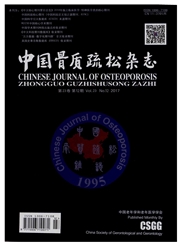

 中文摘要:
中文摘要:
目的调查沈阳和营口地区部分人群骨密度,分析其变化规律和两个地区之间的差异性,为骨质疏松的防治提供科学依据。方法采用GE、LUNAR公司生产的DEXA双能X线骨密度仪对沈阳地区和营口地区2001~2008年来我院体检的3738例健康受试者进行骨密度测定,测量部位为正位L1~L4以及髋部(包括左右股骨颈neck、大粗隆troch、粗隆间Ward三角)。结果沈阳和营口地区男女各部位骨密度峰值均在30~39岁,之后随年龄的增长骨密度开始下降,女性50~60岁骨密度下降速度明显高于男性,男性60-70岁骨密度值明显降低,骨量丢失率增加,骨质疏松患病率升高。沈阳地区和营口地区各年龄段骨密度均不相同,营口地区骨密度的整体水平明显高于沈阳地区,其中男性较为明显。结论本研究为沈阳和营口地区骨质疏松症的诊断、防治提供了参考依据。
 英文摘要:
英文摘要:
Objective To survey the bone mineral density of normal people in Shenyang and Yingkou areas, and analysize the changes and differences between the two regions, to provide a scientific basis for the prevention and treatment of primary osteoporosis. Methods To measure BMD of L1 - L4 and hip joint of 3738 people in Shenyang and Yingkou who came to our hospital for healthy examination from 2001to 2008 by DEXA. Results The peak values of BMD in measured bone was in 30 - 39 age of both male and female group, there was significant difference between Shenyang and Yingkou. The loss of BMD was evident in female group after 50 - 60, but the loss of BMD was evident in male group after 60 - 70. The BMD of all age groups in Shenyang and Yingkou are not the same. The average level of BMD of male and female in Yingkou is significantly higher than in Shenyang. Conclusion This study provides references for the diagnosis and therapy osteoporosis in Shenyang and Yingkou regions.
 同期刊论文项目
同期刊论文项目
 同项目期刊论文
同项目期刊论文
 期刊信息
期刊信息
